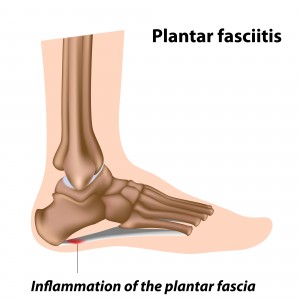Plantar Fasciitis Treatments

Plantar Fasciitis
Plantar Fasciitis can be a debilitating pain located on the bottom of your foot or heel region. It is one of the most common heel injury for athletes, especially runners. The inflammation of Plantar Fasciitis is caused by repeated micro-injury/tears of the plantar fascia-a layer of tissue supporting the arch of your foot that connects your heel bone to your toes. The plantar fascia supports the arch of your foot and holds the whole weight of your body on your foot as you walk or run. Plantar Fasciitis is the acute condition of active inflammation in the plantar fascia. Plantar Fasciitis comes about when it turns into chronic degeneration of the plantar fascia without inflammation. Plantar Fasciitis is sometimes referred to as a heel spur, though this condition does not always lead to a boney growth on the heel.
Symptoms and Causes of Injuries to the Plantar Fasciitis
Plantar Fasciitis is treated by Houston Sports Medicine. The main symptom of Plantar Fasciitis is a stabbing pain on the inside of your heel near the arch of your foot, which may appear suddenly or develop over time. The pain is usually the most intense when you first wake up and put your foot on the floor, known as “first-step pain,” but usually gets better with activity. Long periods of standing, as well as, inactivity can trigger more pain. The pain may also return towards the end of the day. Pain usually increases when weight is placed on the foot. Other symptoms of Plantar Fasciitis include tenderness throughout the bottom of the foot and pain when pulling the toes backward.
Plantar Fasciitis is the acute condition of active inflammation in the plantar fascia. Plantar Fasciitis comes about when it turns into chronic degeneration of the plantar fascia without inflammation. Plantar Fasciitis is sometimes referred to as a heel spur, though this condition does not always lead to a boney growth on the heel.
Plantar Fasciitis can be caused by many factors. Basically, if more stress is placed on the bottom of the foot than it can handle, irritation and inflammation can develop on the heel. Some physical conditions put people at a greater risk of developing Plantar Fasciitis, including: flat feet, low or high arches, weak plantar flexor muscles, tight foot and calf muscles, and other alignment problems in the foot and ankle. In sports, inadequate training and excessive stretching can contribute to Plantar heel injury. Runners are at particular risk of developing Plantar Fasciitis because of the repetitive pushing-off motion. They are also at a greater risk if they run too fast or long without proper preparation. Shoes without adequate support can contribute to Plantar Fasciitis. Also, the pad on the heel of the foot becomes thinner as we age, providing less protection and less shock absorption.
Diagnosis and Treatment of Plantar Fasciitis
Since Plantar Fasciitis is not the only source of heel and foot pain, it is important to be evaluated by a physician to determine a proper diagnosis. At Houston Sports Medicine, Dr. Shaun Lehmann strives to treat heel and foot pain with nonsurgical treatment options that help your body naturally heal itself. Our physician has years of experience treating pain, and they offer multiple nonsurgical treatment options for their patients including: advanced physical therapy, prolotherapy, and Platelet Rich Plasma (PRP). During your initial evaluation, your physician will get a medical history, complete a physical exam, and determine if any diagnostic imaging testing such as MRI or diagnostic ultrasound need to be ordered. In office diagnostic ultrasound is available during your visit, in which the physician can record picture and video of the affected area. Another diagnostic tool available is a force plate analysis to evaluate your gait and determine if orthotics are needed for your feet. After being evaluated, the physicians will provide the treatment plan best suited for your diagnosis.
Houston Sports Medicine is located in The Woodlands, TX. The office is easily reached from the communities of Conroe, Spring, Tomball, Magnolia, Cypress, Kingwood and most other parts of Houston.
